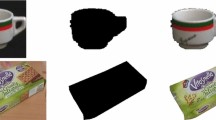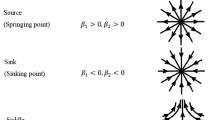Abstract
This paper presents a new approach to the extraction of the contour of a moving object. The method is based on the fusion of a motion segmentation technique using image subtraction and a color segmentation technique based on the split-and-merge paradigm and edge information obtained from using the Canny edge detector. The advantages of this method are the following: it can detect large moving objects, the background can be arbitrarily complicated and contain many nonmoving objects, and it requires only three image frames that need not be consecutive provided that the moving object is entirely contained in the three frames. It is assumed that there is only one moving object in the image and the objects are not blurred by their motion so that the edges in the image are sharp. The method was applied to road images containing a moving vehicle, and the results show that the contour was correctly extracted in 18 of the 20 cases. We show that this contour extraction method gives good results for other types of moving objects as well. We also describe how the extracted contour can be used to classify a given vehicle into five generic categories. In this study, 19 out of the 20 vehicles were correctly classified. These results demonstrate that integration of multiple cues obtained from relatively simple image analysis techniques leads to a robust extraction of the object of interest in complex outdoor scenes.
Similar content being viewed by others
References
Amini, A.A. and Duncan, J.S. 1991. Pointwise tracking of left-ventricular motion in 3D. InProc. IEEE Workshop on Visual Motion, Princeton, NJ, pp. 294–299.
Amini, A.A., Weymouth, T.E., and Jain, R.C. 1990. Using dynamic programming for solving Variational problems in vision.IEEE Trans. Pattern Analysis and Machine Intelligence PAMI-12(9): 855–867.
Ballard, D.H. and Brown, C.M. 1982.Computer Vision. Prentice-Hall: Englewood Cliffs, NJ.
Basri, R. and Ullman, S. 1988. The alignment of objects with smooth surfaces. In.Proc. IEEE Int. Conf. Computer Vision, Tarpon Springs, FL, pp. 482–488.
Beveridge, J.R., Griffith, J., Kohler, R.R., Hanson, A.R. and Riseman, E.M. 1989. Segmenting images using localized histograms and region merging.International Journal of Computer Vision 2: 311–347.
Bouthemy, P. and François, E. 1993. Motion segmentation and qualitative dynamic scene analysis from an image sequence.International Journal of Computer Vision 10(2): 157–182.
Cafforio, C. and Rocca, F. 1976. Methods for measuring small displacements of television images.IEEE Trans. Information Theory IT-22: 573–579.
Canny, J. 1986. A computational approach to edge detection.IEEE Trans. Pattern Analysis Machine Intelligence PAMI-8(6): 679–698.
Coutance, V. 1991. La Couleur en Vision par Ordinateur: Application à la Robotique. Laboratoire d'Automatique et d'Analyse des Systèmes du CNRS, Université Paul Sabatier, Toulouse, France.
Cumani, A., Guiducci, A. and Grattoni, P. 1991. Image description of dynamic scenes.Pattern Recognition 24(7): 661–673.
Du, L., Sullivan, G.D. and Baker, K.D. 1993. Quantitative analysis of the viewpoint consistency constraint in model-based vision. InProc. IEEE Int. Conf. Computer Vision, Berlin, Germany, pp. 632–639.
Dubuisson, M.-P. and Jain, A.K. 1993. Object contour extraction using color and motion. InProc. IEEE Conf. Computer Vision and Pattern Recognition, New York, NY, pp. 471–476.
Dudani, S., Breeding, K. and McGhee, R. 1977. Aircraft identification by moment invariants.IEEE Trans. Computers C-26 (1): 39–45.
Duncan, J. and Chou, T.-C. 1992. On the detection of motion and the computation of optical flow.IEEE Trans. Pattern Analysis Machine Intelligence PAMI-14(3): 346–352.
Etoh, M. and Shirai, Y. 1993. Segmentation and 2D motion estimation by region fragments. InProc. IEEE Int. Conf. Computer Vision, Berlin, Germany, pp. 192 –199.
Farrokhnia, F. and Jain, A.K. 1991. A multi-channel filtering approach to texture segmentation. InProc. IEEE Conf. Computer Vision and Pattern Recognition, Maui, HI, pp. 364–370.
Fennema, C.L. and Thompson, W.B. 1979. Velocity determination in scenes containing several moving objects.Computer Graphics and Image Processing 9: 301–315.
Fleet, D.J. and Jepson, A.D. 1990. Computation of component image velocity from local phase information.International Journal of Computer Vision 5(1): 77–104.
Frazier, J. and Nevatia, R. 1990. Detecting moving objects from a moving platform. InProc. DARPA Image Understanding Workshop, Pittsburgh, PA, pp. 348–355.
Heeger, D.J. 1988. Optical flow using spationtemporal filters.International Journal of Computer Vision 2(4): 279–302.
Horn, B.K.P. and Schunck, B. 1981. Determining optical flow.Artificial Intelligence 17: 185–203.
Horowitz, S. and Pavlidis, T. 1976. Picture segmentation by a tree traversal algorithm.Journal of the ACM 23(2): 368–388.
Hsu, Y.Z., Nagel, H.-H. and Rekers, G. 1984. New likelihood test methods for change detection in image sequences.Computer Vision, Graphics, and Image Processing 26: 73–106.
Jain, A.K. and Dubes, R.K. 1988.Algorithms for Clustering Data. Prentice Hall: Englewood Cliffs, NJ.
Jain, A.K. and Flynn, P.J. 1993.3D Object Recognition Systems. Elsevier: Amsterdam.
Jain, R., Martin, W.N. and Aggarwal, J.K. 1979. Segmentation through the detection of changes due to motion.Computer Graphics and Image Processing 11: 13–34.
Jain R. and Nagel, H.-H. 1979. On the analysis of accumulative difference pictures from image sequences of real world scenes.IEEE Trans. Pattern Analysis Machine Intelligence PAMI-1(2): 206–214.
Kass, M., Witkin, A. and Terzopoulos, D. 1988. Snakes: active contour models.International Journal of Computer Vision: 321–331.
Kearney, J.K., Thompson, W.B. and Boley, D.L. 1987. Optical flow estimation: an error analysis of gradient-based methods with local optimization.IEEE Trans. Pattern Analysis and Machine Intelligence PAMI-9(2): 229–244.
Kilger, M. 1992. A shadow handler in a video-based realtime traffic monitoring system. InProc. IEEE Workshop on Applications of Computer Vision, Palm Spring, CA.
Kluge, K., Kanade, T. and Kuga, H. 1990. Car recognition for the CMU Navlab. InVision and Navigation. The Carnegie Mellon Navlab (ed., C.E. Thorpe), Kluwer Academic Publisher, pp. 95–115.
Koller, D., Heinze, N. and Nagel, H.-H. 1991. Algorithmic characterization of vehicle trajectories from image sequences by motion verbs. InProc. IEEE Conf. Computer Vision and Pattern Recognition, Maui, HI, pp. 90–95.
Mao, J. and Jain, A.K. 1992. Texture classification and segmentation using multiresolution simultaneous autoregressive models.Pattern Recognition 25(2): 173–188.
Milgram, D.L. 1979. Region extraction using convergent evidence.Computer Graphics and Image Processing 11: 1–12.
Miller, K.S., Harvey, T.N., Shuldiner, P.W. and Ho, C. 1993. Using video technology to conduct the 1991 Boston region external cordon survey. InProc. Transportation Research Board Annual Meeting, paper no. 930892, Washington, DC.
Nagel, H.-H. 1986. Image sequences — Ten (octal) years — From phenomenology towards a theoretical foundation. InProc. Int. Conf. on Pattern Recognition, Paris, France, pp. 1174–1185.
Nagel, H.-H. and Enkelmann, W. 1986. An investigation of smoothness constraints for the estimation of displacement vector fields from image sequences.IEEE Trans. Pattern Analysis and Machine Intelligence PAMI-8(5): 565–593.
Nakanishi, T. and Ishii, K. 1992. Automatic vehicle image extraction based on spatio-temporal image analysis. InProc. Int. Conf. Pattern Recognition, The Hague, Netherlands, pp. 500–504.
Noll, D., Schwarzinger, M. and von Seelen, W. 1993. Contextual feature similarities for model-based object recognition. InProc. IEEE Int. Conf. Computer Vision, Berlin, Germany, pp. 286–290.
Ohlander, R., Price, K. and Reddy, D.R. 1978. Picture segmentation using a recursive region splitting method.Computer Graphics and Image Processing 8: 313–333.
Ohta, Y.-I., Kanade, T. and Sakai, T. 1980. Color information for region segmentation.Computer Graphics and Image Processing 13: 222–241.
Pavlidis, T. and Liow, Y.-T. 1990. Integrating region growing and edge detection.IEEE Trans. Pattern Analysis Machine Intelligence PAMI-12(3): 225–233.
Pentland, A., Horowitz, B. and Sclaroff, S. 1991. Nonrigid motion and structure from contour. InProc. IEEE Workshop on Visual Motion, Princeton, NJ, pp. 288–293.
Rom, H. and Medioni, G. 1992. Hierarchical decomposition and axial shape description. InProc. IEEE Conf. Computer Vision and Pattern Recognition, Urbana, IL, pp. 49–55.
Seibert, M. and Waxman, A.M. 1992. Adaptive 3-D object recognition from multiple views.IEEE Trans. Pattern Analysis Machine Intelligence PAMI-14(2): 107–123.
Sethi, I.K. and Brillhart, W.L. 1991. Traffic analysis including non-conforming behavior via image processing. InProc. Conf. Vehicle Navigation and Information Systems, Dearborn, MI, pp. 193–201.
Shio, A. and Sklansky, J. 1991. Segmentation of people in motion. InIEEE Workshop on Visual Motion, Princeton, NJ, pp. 325–332.
Stein, F. and Medioni, G. 1990. Efficient two dimensional object recognition. InProc. Int. Conf. Pattern Recognition, Atlantic City, NJ, pp. 13–17.
Thompson, W.B. and Barnard, S.T. 1981. Low-level estimation and interpretation of visual motion.Computer 14: 20–28.
Thompson, W.B. and Pong, T.-C. 1987. Detecting moving objects. InProc. IEEE Int. Conf. Computer Vision, London, England, pp. 201–208.
TRB. 1991. Transportation Research Board.Advanced Vehicle and Highway Technologies, National Research Council, Report No. 232.
Weng, J. 1993. Image matching using the windowed Fourier phase.International Journal of Computer Vision 11(3): 211–236.
Weng, J., Ahuja, N. and Huang, T.S. 1992. Matching two perspective views.IEEE Trans. Pattern Analysis and Machine Intelligence PAMI-14(8): 806–825.
Zimmermann, G. and Kories, R. 1988. What an autonomous robot can learn about its environment starting from scratch using image sequences? InReal-Time Object Measurement and Classification (ed., A.K. Jain), Springer Verlag, pp. 215–226.
Author information
Authors and Affiliations
Additional information
Research supported by a grant from the U.S. Department of Transportation through the Great Lakes Center for Truck Transportation Research and by a grant from the National Science Foundation (CDA-8806599).
Rights and permissions
About this article
Cite this article
Dubuisson, MP., Jain, A.K. Contour extraction of moving objects in complex outdoor scenes. Int J Comput Vision 14, 83–105 (1995). https://doi.org/10.1007/BF01421490
Received:
Revised:
Issue Date:
DOI: https://doi.org/10.1007/BF01421490




